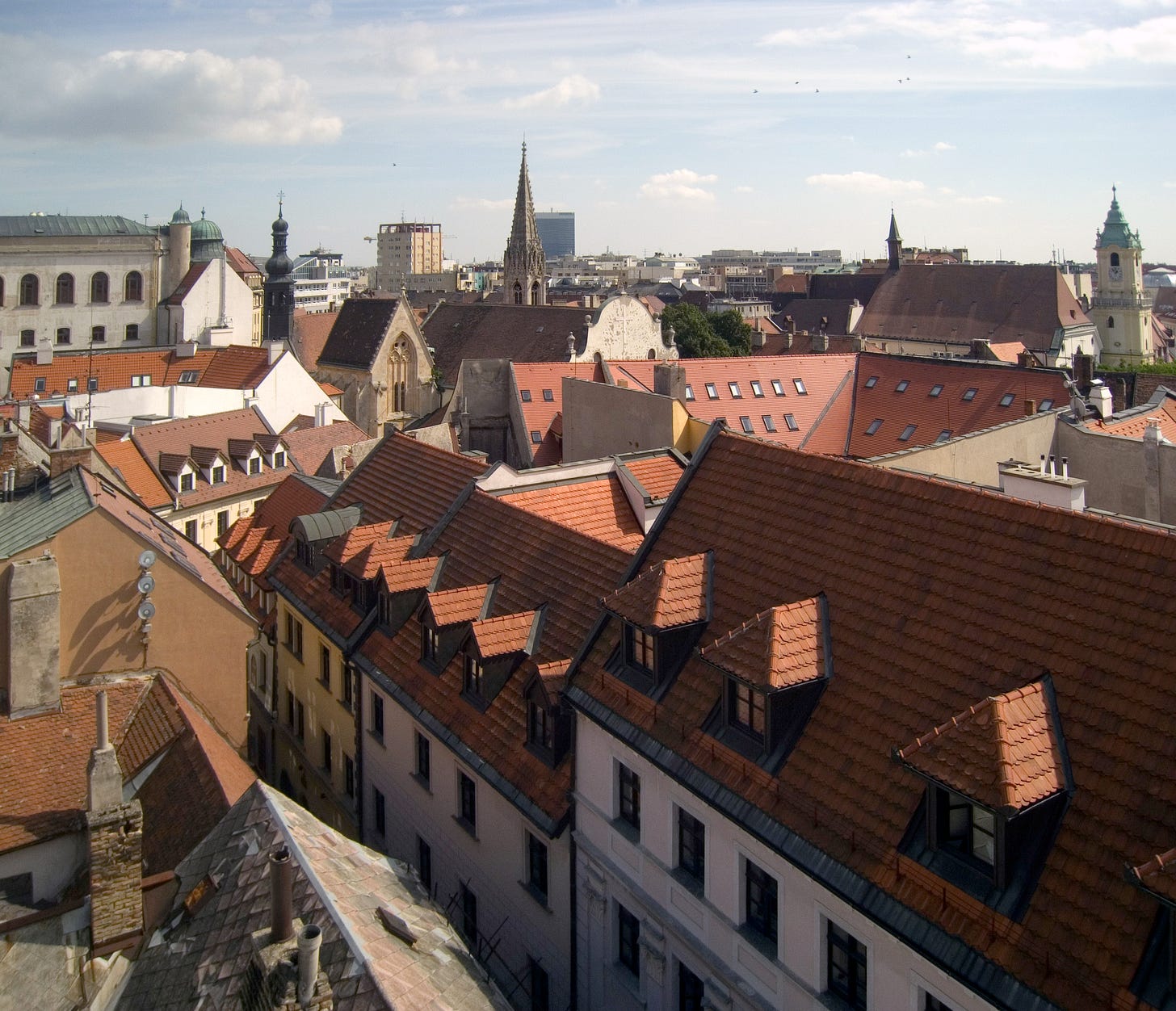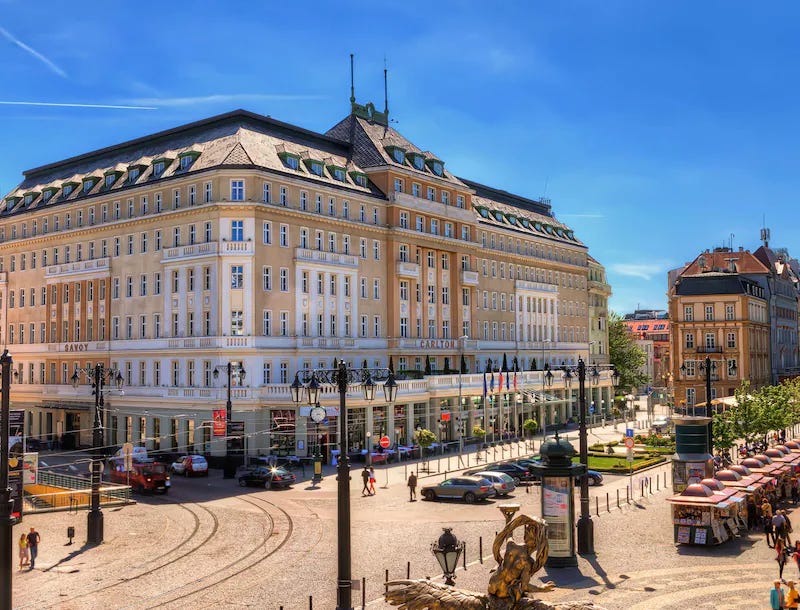Spirit of Place: Free at last in the new Slovakia
When Communism fell in the Slovak capital of Bratislava, it fell hard. I was there for the good times. So was my friend Maria. But capitalism sometimes means "anything goes."
My Slovakian friend Maria could never understand why I always stayed at the Hotel Carlton when I visited Bratislava, the capital of Slovakia. Maria, who worked in one of the city’s tourist offices, usually referred Western visitors to modern establishments like the Forum or the Kijev. It’s true that the Carlton had seen better days, but that’s why I liked it. Today it’s a Radisson Hotel, but under Communism its peeling wallpaper and disreputable clientele (lots of Soviet agents lurking, or so it appeared to me) were atmospherically seamy.
I first knew Bratislava when Czechoslovakia was still under Communist rule. I traveled often on assignment from my home in Paris to Vienna. During one visit in 1989, with some time to spare, I decided to venture the 35 miles down the Danube to Bratislava on the regular bus route that crossed the Iron Curtain from the Free World. I had never been in a Communist country before, but the way things were going in the Soviet Union and Eastern Europe, I had a dim realization that this might be my last chance.
My first trip to Bratislava came just six months before the 1989 Velvet Revolution freed the Czechs and Slovaks from the absurdities of Communist rule. Vaclav Havel was still in jail, and Alexander Dubcek—the leader of the 1968 Prague Spring and one of the few Slovaks ever to gain international fame—remained under house arrest in his apartment near Bratislava’s town center.
The 35 mile bus trip took two hours, at least half of which was spent at the Austrian-Czechoslovak frontier where our passports and other papers were thoroughly examined by border guards. (Not half as thoroughly, however, as when I returned to Vienna by train three days later, and the guards searched under every seat and in all the toilets for anyone trying to leave the worker’s paradise. Any illusions I might have still harbored about actual living socialism were smashed that day.)
I easily checked into the Carlton (it never occurred to me to make a reservation) and ventured into the city center. I wondered into the tourist office looking for a map of the town, but the English-speaking member of the staff was out on an errand.
“Français?” I asked. A pretty, dark-haired young woman looked up from her desk and smiled at me. Maria spoke fluent French, even though she had only been to France once in her life. I went back to see her two or three times during that visit, getting her advice on things to see and do, and, very importantly, where to eat. At first our conversations were short and businesslike, although I wanted to ask her more and I felt she wanted to say more. But I was worried that one of her colleagues might also speak French. When Maria made a cryptic comment about how bad things were in her country, I didn’t pursue it.
I returned to Bratislava the following year, a few months after the revolution. The city was plastered with the blue and red posters of Public Against Violence, the Slovak counterpart to Havel’s Prague-based Civic Forum. The Cafe Lyra, across the street from the Academia Istropolitano, was so packed with student activists I could not find an empty seat.
I walked into Maria’s office and found her at her desk. She was surprised and happy to see me. “A lot has changed since the last time I was here!” I said with a laugh. “Are you happy?”
“Of course,” she said, beaming with the satisfaction of someone who at last has been allowed to tell a great secret. We became real friends from that moment.
The next day I took Maria to lunch at the Hotel Forum. She was a proud and spirited young woman, and apologized profusely because she couldn’t afford to pay her share of the meal. I told her not to worry about it. As she relaxed, she began to tell me her story. She was born in 1964 and grew up in the spa town of Piest’any, about an hour’s bus drive from Bratislava. Her father had spent two years in prison during the 1950s for helping a friend escape to the United States.
“My earliest memory is from 1968,” Maria said as she relished a Slovak canape. “My mother came home crying and said that we had to stock up on food, because 70,000 Soviet troops had just marched into Bratislava and taken over all the shops.”
Not surprisingly, Maria was rabidly anti-Communist. A bit too much so, I thought. At one point I suggested that there were some features of socialism that might be—
“Like what?” she demanded, glaring at me. I realized that my position was precarious. Here I was, having lunch in the plushest hotel in Bratislava, about to defend socialism to someone who had lived under Stalinism all her life.
My last visit to Bratislava was in 1992, on the eve of an election that would return the authoritarian nationalist Vladimir Meciar to power in Slovakia and lead to the breakup with the Czechs. I found Maria in the middle of a crisis. She had just been thrown out of her apartment by her landlady, even though she had signed a lease and paid six months’ rent in advance—all of her savings. It seemed that her landlady thought capitalism meant “anything goes,” and refused to give Maria her money back.
Maria didn’t know what her rights were—or even if she had any at all—so she had gathered up her possessions and moved in with a friend in one of the dreary apartment blocks on the edge of Bratislava. At my urging, she went to see a lawyer, who laughed and said he had seen much worse cases. Nevertheless, he agreed to help her, for a stiff fee.
Meanwhile, an executive from a Belgian manufacturing firm was pestering Maria to quit her job at the tourist office and go to work as the company’s representative in Slovakia. She was sorely tempted. While a lot of former Communists were becoming wealthy by using their connections to buy up Bratislava’s shops and businesses, three years after the revolution Maria was still making only about $100 per month—just slightly more than her salary under the ancien regime. The Belgian was offering her four times that. It was a pitiful sum by Western standards, but it could make a big difference in Maria’s life. Yet if she gave up her job and later things didn’t work out with her new boss, she would join the ranks of the half-million Slovaks already thrown out of work by the closing of unprofitable factories and businesses.
Despite her troubles, Maria was still able to laugh and have a good time. She had been a free spirit under Communism, and she was determined to remain so under the capitalists. “If things get too bad, at least I am free to kill myself,” she said gaily.
We made our customary rounds of Bratislava’s cafes and restaurants, which had much improved with the free market. One night we went to an excellent new Italian restaurant, where, Maria told me in shocked tones, you actually had to make a reservation to get in.
On my last evening in the city, I took Maria to see a local production of “Death of a Salesman.” It was in Slovak, but as she knew the language and I knew the play, we were both able to make sense of it. Arthur Miller’s fable about Willy Loman, the traveling salesman to buys into the American dream only to be tossed onto the rubbish heap, is such a chestnut of the American theater that I was a little taken aback by the audience’s reaction. Long before the final curtain, a lot of people had begun to cry, and when Willy’s wife uttered the play’s final lines at her husband’s funeral—”We’re free, we’re free, we’re free”—someone in the front row broke into loud sobs.
As we left the theater, Maria took my arm. “If I take this job with the Belgian, do you think I could end up like Willy Loman?” she asked. She was smiling, but her eyes were serious.
“No, Maria,” I said, smiling back at her. “Not you.”
Note: I never saw Maria after that last visit, although we wrote each other (in French) for several years afterwards. She told me to use her parents’ address in Piest’any as they would always know where she was. I never got an answer to my last two letters, so I don’t know what happened to Maria, who would be about 57 years old now. But I have never stopped thinking about her.






